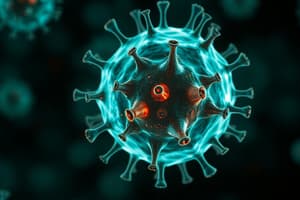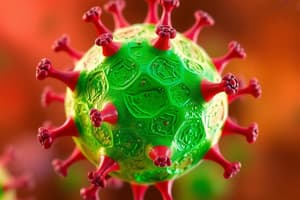Podcast
Questions and Answers
What is the process by which circulating cells become targets for phagocytosis by neutrophils and macrophages?
What is the process by which circulating cells become targets for phagocytosis by neutrophils and macrophages?
- Opsonization with autoantibodies and complement proteins (correct)
- Formation of immune complexes with exogenous antigens
- Activation of the complement system by the alternative pathway
- Phagocytosis of cells by antibody-mediated cellular dysfunction
What is the primary function of products of complement activation in inflammation?
What is the primary function of products of complement activation in inflammation?
- To recruit neutrophils and monocytes, triggering inflammation (correct)
- To activate the alternative pathway of complement activation
- To form immune complexes with endogenous antigens
- To impair cellular function without causing cell injury or inflammation
What is an example of antibody-mediated cellular dysfunction?
What is an example of antibody-mediated cellular dysfunction?
- Rheumatoid arthritis, where immune complexes deposit in joints
- Lupus, where immune complexes deposit in the kidneys
- Myasthenia gravis, where antibodies against acetylcholine receptors impair neuromuscular transmission (correct)
- Type I hypersensitivity, where IgE antibodies trigger an allergic response
What is the condition under which immune complexes are pathogenic?
What is the condition under which immune complexes are pathogenic?
What is the term for the type of hypersensitivity characterized by immune complex-mediated injury?
What is the term for the type of hypersensitivity characterized by immune complex-mediated injury?
What is the term used to describe an immune response that results in exaggerated or inappropriate reactions harmful to the host?
What is the term used to describe an immune response that results in exaggerated or inappropriate reactions harmful to the host?
What is the outcome of immune complex-mediated injury when complexes are formed and deposited in a specific site?
What is the outcome of immune complex-mediated injury when complexes are formed and deposited in a specific site?
What is the type of hypersensitivity reaction that occurs within minutes of exposure to an antigen?
What is the type of hypersensitivity reaction that occurs within minutes of exposure to an antigen?
What is the term used to describe the movement of WBC's in response to chemical attractants?
What is the term used to describe the movement of WBC's in response to chemical attractants?
What is the result of an immune response to microbial antigens that triggers inflammation in tissues?
What is the result of an immune response to microbial antigens that triggers inflammation in tissues?
What is the type of hypersensitivity disease caused by antibodies directed against target antigens on the surface of cells or other tissue components?
What is the type of hypersensitivity disease caused by antibodies directed against target antigens on the surface of cells or other tissue components?
What is the second phase of the pathogenesis of systemic immune complex disease?
What is the second phase of the pathogenesis of systemic immune complex disease?
What is the term used to describe the failure of self-tolerance leading to an immune response against an individual's own antigens?
What is the term used to describe the failure of self-tolerance leading to an immune response against an individual's own antigens?
What is the type of hypersensitivity reaction that occurs in response to environmental antigens such as pollens, animal danders, and dust?
What is the type of hypersensitivity reaction that occurs in response to environmental antigens such as pollens, animal danders, and dust?
What type of T cells are responsible for cytokine-mediated inflammation?
What type of T cells are responsible for cytokine-mediated inflammation?
What is the clinical manifestation of a severe, systemic, and potentially life-threatening allergic reaction?
What is the clinical manifestation of a severe, systemic, and potentially life-threatening allergic reaction?
Which of the following diseases is NOT caused by TH1 and TH17 reactions against self-antigens?
Which of the following diseases is NOT caused by TH1 and TH17 reactions against self-antigens?
What is the main function of cytokines produced by CD4+ T cells?
What is the main function of cytokines produced by CD4+ T cells?
What type of T cells are responsible for direct cell cytotoxicity?
What type of T cells are responsible for direct cell cytotoxicity?
What is the term for the type of hypersensitivity reaction caused by T cells?
What is the term for the type of hypersensitivity reaction caused by T cells?
What is the name of the type of T cell reaction that involves the secretion of cytokines?
What is the name of the type of T cell reaction that involves the secretion of cytokines?
What is the term for the cells that are the major effector cells of injury in cytokine-mediated inflammation?
What is the term for the cells that are the major effector cells of injury in cytokine-mediated inflammation?
Which autoimmune disease is characterized by the production of a large number of autoantibodies that can damage tissues?
Which autoimmune disease is characterized by the production of a large number of autoantibodies that can damage tissues?
What is the underlying cause of the breakdown in self-tolerance in Systemic Lupus Erythematosus?
What is the underlying cause of the breakdown in self-tolerance in Systemic Lupus Erythematosus?
Which of the following is NOT a manifestation of Systemic Lupus Erythematosus?
Which of the following is NOT a manifestation of Systemic Lupus Erythematosus?
What is the primary characteristic of Rheumatoid Arthritis?
What is the primary characteristic of Rheumatoid Arthritis?
What is the term used to describe the secondary form of Sjögren syndrome?
What is the term used to describe the secondary form of Sjögren syndrome?
Which of the following is an environmental factor that may contribute to the development of Systemic Lupus Erythematosus?
Which of the following is an environmental factor that may contribute to the development of Systemic Lupus Erythematosus?
Which autoimmune disease is characterized by immune-mediated destruction of the lacrimal and salivary glands?
Which autoimmune disease is characterized by immune-mediated destruction of the lacrimal and salivary glands?
Which of the following organs is NOT typically affected by Systemic Lupus Erythematosus?
Which of the following organs is NOT typically affected by Systemic Lupus Erythematosus?
What is the primary mechanism by which microbes trigger autoimmunity?
What is the primary mechanism by which microbes trigger autoimmunity?
Which of the following is a risk factor for rheumatoid arthritis (RA)?
Which of the following is a risk factor for rheumatoid arthritis (RA)?
What is the term for the phenomenon where an immune response against a microbe cross-reacts with self tissues?
What is the term for the phenomenon where an immune response against a microbe cross-reacts with self tissues?
Which of the following is a characteristic of autoimmune diseases?
Which of the following is a characteristic of autoimmune diseases?
What is the result of local tissue injury in terms of autoimmune responses?
What is the result of local tissue injury in terms of autoimmune responses?
Which of the following is NOT a mechanism by which microbes trigger autoimmunity?
Which of the following is NOT a mechanism by which microbes trigger autoimmunity?
What is the term for the immune response against self antigens?
What is the term for the immune response against self antigens?
What is a characteristic of autoimmune diseases in terms of gender?
What is a characteristic of autoimmune diseases in terms of gender?
Flashcards are hidden until you start studying
Study Notes
Chemotaxis and Inflammation
- Chemotaxis is the movement of WBCs in response to chemical attractants
- During inflammation, WBCs, dead tissue, and bacterial cells accumulate, forming pus
- Inflammatory exudate becomes thick with WBCs, leading to tissue damage
Hypersensitivity
- Hypersensitivity is an exaggerated or inappropriate immune response that harms the host
- Causes of hypersensitivity:
- Autoimmunity: failure of self-tolerance
- Reaction against microbes: excessive reactions or persistent antigens
- Reaction against environmental antigens: pollens, animal danders, dust
Types of Hypersensitivity Diseases
- Immediate (Type I) Hypersensitivity:
- Rapid immune reaction within minutes
- Interaction of antigen and IgE antibody on mast cells in sensitized hosts
- Examples: seasonal rhinitis, hay fever, asthma, anaphylaxis
- Antibody-Mediated Diseases (Type II Hypersensitivity):
- Caused by antibodies directed against target antigens on cells or tissue components
- Mechanisms:
- Opsonization and phagocytosis
- Inflammation
- Antibody-mediated cellular dysfunction
- Examples: myasthenia gravis, autoimmune hemolytic anemia
- Immune Complex Diseases (Type III Hypersensitivity):
- Antigen-antibody complexes formed in the circulation deposit in blood vessels, leading to complement activation and inflammation
- Examples: poststreptococcal glomerulonephritis, systemic lupus erythematosus
- T Cell-Mediated (Type IV) Hypersensitivity:
- Caused by T cells, leading to tissue injury and disease
- Mechanisms:
- Cytokine-mediated inflammation
- Direct cell cytotoxicity
- Examples: autoimmune disorders, pathologic reactions to environmental chemicals and persistent microbes
Autoimmunity
- Definition: immune response against self (auto-) antigens, resulting in tissue damage
- General principles:
- Pathogenesis: combination of susceptibility genes and environmental triggers
- Different autoimmune diseases may be systemic or organ-specific
- Triggers:
- Microbes (bacteria, viruses, mycoplasmas) through molecular mimicry
- Environmental insults (UV radiation, smoking)
- Family history and genetic polymorphisms
Autoimmune Diseases
- Systemic Lupus Erythematosus (SLE):
- Fundamental defect: production of autoantibodies that can damage tissues
- Disease manifestations: nephritis, skin lesions, arthritis, hematologic and neurologic abnormalities
- Unknown underlying cause: excess or persistence of nuclear antigens, genetic factors, environmental factors
- Rheumatoid Arthritis (RA):
- Systemic, chronic inflammatory disease affecting many tissues, primarily joints
- Produces nonsuppurative proliferative synovitis, leading to articular cartilage and bone destruction
- Sjögren Syndrome:
- Clinicopathologic entity characterized by dry eyes and dry mouth
- Resulting from immune-mediated destruction of lacrimal and salivary glands
- Primary form (sicca syndrome) or secondary form (associated with another autoimmune disease)
Studying That Suits You
Use AI to generate personalized quizzes and flashcards to suit your learning preferences.



